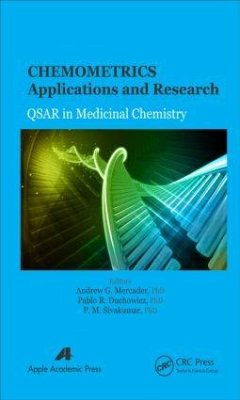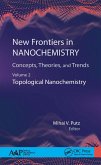Chemometrics Applications and Research
Qsar in Medicinal Chemistry
Herausgeber: Mercader, Andrew G; Sivakumar, P M; Duchowicz, Pablo R
Chemometrics Applications and Research
Qsar in Medicinal Chemistry
Herausgeber: Mercader, Andrew G; Sivakumar, P M; Duchowicz, Pablo R
- Gebundenes Buch
- Merkliste
- Auf die Merkliste
- Bewerten Bewerten
- Teilen
- Produkt teilen
- Produkterinnerung
- Produkterinnerung
This important new book provides innovative material, including peer-reviewed chapters and survey articles on new applied research and development, in the scientifically important field of QSAR in medicinal chemistry. QSAR is a growing field because available computing power is continuously increasing. This important new book provides innovative material, including peer-reviewed chapters and survey articles on new applied research and development, in the scientifically important field of QSAR in medicinal chemistry.
Andere Kunden interessierten sich auch für
![Chemical Technology and Informatics in Chemistry with Applications Chemical Technology and Informatics in Chemistry with Applications]() Chemical Technology and Informatics in Chemistry with Applications180,99 €
Chemical Technology and Informatics in Chemistry with Applications180,99 €![Progress in Organic and Physical Chemistry Progress in Organic and Physical Chemistry]() Progress in Organic and Physical Chemistry185,99 €
Progress in Organic and Physical Chemistry185,99 €![Research Methodology in Physics and Chemistry of Surfaces and Interfaces Research Methodology in Physics and Chemistry of Surfaces and Interfaces]() Research Methodology in Physics and Chemistry of Surfaces and Interfaces197,99 €
Research Methodology in Physics and Chemistry of Surfaces and Interfaces197,99 €![Quantum Nanochemistry, Volume One Quantum Nanochemistry, Volume One]() Mihai V PutzQuantum Nanochemistry, Volume One277,99 €
Mihai V PutzQuantum Nanochemistry, Volume One277,99 €![Multifunctional Materials and Modeling Multifunctional Materials and Modeling]() Multifunctional Materials and Modeling197,99 €
Multifunctional Materials and Modeling197,99 €![Quantum Nanochemistry, Volume Three Quantum Nanochemistry, Volume Three]() Mihai V PutzQuantum Nanochemistry, Volume Three277,99 €
Mihai V PutzQuantum Nanochemistry, Volume Three277,99 €![New Frontiers in Nanochemistry New Frontiers in Nanochemistry]() New Frontiers in Nanochemistry189,99 €
New Frontiers in Nanochemistry189,99 €-
-
-
This important new book provides innovative material, including peer-reviewed chapters and survey articles on new applied research and development, in the scientifically important field of QSAR in medicinal chemistry. QSAR is a growing field because available computing power is continuously increasing. This important new book provides innovative material, including peer-reviewed chapters and survey articles on new applied research and development, in the scientifically important field of QSAR in medicinal chemistry.
Hinweis: Dieser Artikel kann nur an eine deutsche Lieferadresse ausgeliefert werden.
Hinweis: Dieser Artikel kann nur an eine deutsche Lieferadresse ausgeliefert werden.
Produktdetails
- Produktdetails
- Verlag: Apple Academic Press
- Seitenzahl: 458
- Erscheinungstermin: 11. März 2016
- Englisch
- Abmessung: 234mm x 163mm x 30mm
- Gewicht: 794g
- ISBN-13: 9781771881135
- ISBN-10: 1771881135
- Artikelnr.: 42526172
- Herstellerkennzeichnung
- Libri GmbH
- Europaallee 1
- 36244 Bad Hersfeld
- 06621 890
- Verlag: Apple Academic Press
- Seitenzahl: 458
- Erscheinungstermin: 11. März 2016
- Englisch
- Abmessung: 234mm x 163mm x 30mm
- Gewicht: 794g
- ISBN-13: 9781771881135
- ISBN-10: 1771881135
- Artikelnr.: 42526172
- Herstellerkennzeichnung
- Libri GmbH
- Europaallee 1
- 36244 Bad Hersfeld
- 06621 890
Andrew G. Mercader, PhD, studied physical chemistry at the Faculty of Chemistry of La Plata National University (UNLP), Buenos Aires, Argentina, from 1995-2001. Afterwards he joined Shell Argentina to work as the luboil, asphalts and distillation process technologist, as well as the safeguarding and project technologist, from 2001-2006. Dr. Mercader's PhD work on the development and applications of QSAR/QSPR theory was performed at the Theoretical and Applied Research Institute at La Plata National University (INIFTA) from 2006-2009. After that he obtained a post-doctoral scholarship to work on theoretical-experimental studies of biflavonoids, at IBIMOL (ex PRALIB), Faculty of Pharmacy and Biochemistry, University of Buenos Aires (UBA), from 2009-2012. He is currently a member of the Scientific Researcher Career in the Argentina National Research Council at INIFTA. Pablo R. Duchowicz, PhD, studied physical chemistry from 1996-2003 at the Faculty of Exact Sciences, Chemistry Department of La Plata National University (UNLP), Buenos Aires, Argentina. His PhD work on "Physicochemical and Biological Applications of the QSPR" was performed at the Research Institute of Theoretical and Applied Physical-Chemistry (INIFTA), located at La Plata, under the supervision of Professors Eduardo A. Castro and Francisco M. Fernández, from 2003-2005. In 2006 he obtained a post-doctoral scholarship to work on "ab initio Direct Kinetics and Molecular Dynamics Studies for Halogenated Germanes and Related Species" at INIFTA, under the supervision of Dr. Carlos J. Cobos and Professor Adela Croce. Since 2007, he has been a member of the Scientific Researcher Career of the National Research Council of Argentina, performing research work at INIFTA. P. M. Sivakumar, PhD, is a foreign postdoctoral researcher (FPR) at RIKEN, Wako Campus, in Japan. RIKEN is Japan's largest comprehensive research institution renowned for high-quality research in a diverse range of scientific disciplines. He received his PhD from the Department of Biotechnology, Indian Institute of Technology Madras, India. He is a member of the editorial boards of several journals and has published papers in international peer-reviewed journals and professional conferences. His research interests include drug discovery, QSAR, and biomaterials.
Preface. Overview and Recent Advances in QSAR Studies. Software and Web
Resources for Computer-Aided Molecular Modeling and Drug Discovery. The
Rm2 Metrics for Validation of QSAR/QSPR Models. Considering the Molecular
Conformational Flexibility in QSAR Studies. Practical Aspects of Building,
Validation and Application of 3D-Pharmacophore Models. Application of
Conceptual Density Functional Theory in Developing QSAR Models and Their
Usefulness in the Prediction of Biological Activity and Toxicity of
Molecules. Synopsis of Chemometric Applications to Model PPAR Agonism.
Antimicrobial and Immunosuppressive Activitites of Cyclopeptides as Targets
for Medicinal Chemistry. On the Use of Quantitative Structure Activity
Relationships (QSAR) and Global Reactivity Descriptors to Study the
Biological Activities of Polychlorinated Biphenyls (PCBs). Applications of
Quantitative Structure-Relative Sweetness Relationships in Food Chemistry.
QSAR Studies of 1, 4-Benzodiazepines as CCKA Antagonist. Docking-Based
Scoring Parameters Based QSAR Modeling on a Dataset of
Bisphenylbenzimidazole as Non-Nucleoside Reverse Transcriptase Inhibitor.
Potential Anti-Inflammatory and Anti-Proliferative
Agents.-1h-Isochromen-1-Ones and Their Thio Analogues and Their QSAR
Studies. QSAR Studies on Dihydrofolate Reductase Enzyme: From Model to
Biological Activity. Index.
Resources for Computer-Aided Molecular Modeling and Drug Discovery. The
Rm2 Metrics for Validation of QSAR/QSPR Models. Considering the Molecular
Conformational Flexibility in QSAR Studies. Practical Aspects of Building,
Validation and Application of 3D-Pharmacophore Models. Application of
Conceptual Density Functional Theory in Developing QSAR Models and Their
Usefulness in the Prediction of Biological Activity and Toxicity of
Molecules. Synopsis of Chemometric Applications to Model PPAR Agonism.
Antimicrobial and Immunosuppressive Activitites of Cyclopeptides as Targets
for Medicinal Chemistry. On the Use of Quantitative Structure Activity
Relationships (QSAR) and Global Reactivity Descriptors to Study the
Biological Activities of Polychlorinated Biphenyls (PCBs). Applications of
Quantitative Structure-Relative Sweetness Relationships in Food Chemistry.
QSAR Studies of 1, 4-Benzodiazepines as CCKA Antagonist. Docking-Based
Scoring Parameters Based QSAR Modeling on a Dataset of
Bisphenylbenzimidazole as Non-Nucleoside Reverse Transcriptase Inhibitor.
Potential Anti-Inflammatory and Anti-Proliferative
Agents.-1h-Isochromen-1-Ones and Their Thio Analogues and Their QSAR
Studies. QSAR Studies on Dihydrofolate Reductase Enzyme: From Model to
Biological Activity. Index.
Preface. Overview and Recent Advances in QSAR Studies. Software and Web
Resources for Computer-Aided Molecular Modeling and Drug Discovery. The
Rm2 Metrics for Validation of QSAR/QSPR Models. Considering the Molecular
Conformational Flexibility in QSAR Studies. Practical Aspects of Building,
Validation and Application of 3D-Pharmacophore Models. Application of
Conceptual Density Functional Theory in Developing QSAR Models and Their
Usefulness in the Prediction of Biological Activity and Toxicity of
Molecules. Synopsis of Chemometric Applications to Model PPAR Agonism.
Antimicrobial and Immunosuppressive Activitites of Cyclopeptides as Targets
for Medicinal Chemistry. On the Use of Quantitative Structure Activity
Relationships (QSAR) and Global Reactivity Descriptors to Study the
Biological Activities of Polychlorinated Biphenyls (PCBs). Applications of
Quantitative Structure-Relative Sweetness Relationships in Food Chemistry.
QSAR Studies of 1, 4-Benzodiazepines as CCKA Antagonist. Docking-Based
Scoring Parameters Based QSAR Modeling on a Dataset of
Bisphenylbenzimidazole as Non-Nucleoside Reverse Transcriptase Inhibitor.
Potential Anti-Inflammatory and Anti-Proliferative
Agents.-1h-Isochromen-1-Ones and Their Thio Analogues and Their QSAR
Studies. QSAR Studies on Dihydrofolate Reductase Enzyme: From Model to
Biological Activity. Index.
Resources for Computer-Aided Molecular Modeling and Drug Discovery. The
Rm2 Metrics for Validation of QSAR/QSPR Models. Considering the Molecular
Conformational Flexibility in QSAR Studies. Practical Aspects of Building,
Validation and Application of 3D-Pharmacophore Models. Application of
Conceptual Density Functional Theory in Developing QSAR Models and Their
Usefulness in the Prediction of Biological Activity and Toxicity of
Molecules. Synopsis of Chemometric Applications to Model PPAR Agonism.
Antimicrobial and Immunosuppressive Activitites of Cyclopeptides as Targets
for Medicinal Chemistry. On the Use of Quantitative Structure Activity
Relationships (QSAR) and Global Reactivity Descriptors to Study the
Biological Activities of Polychlorinated Biphenyls (PCBs). Applications of
Quantitative Structure-Relative Sweetness Relationships in Food Chemistry.
QSAR Studies of 1, 4-Benzodiazepines as CCKA Antagonist. Docking-Based
Scoring Parameters Based QSAR Modeling on a Dataset of
Bisphenylbenzimidazole as Non-Nucleoside Reverse Transcriptase Inhibitor.
Potential Anti-Inflammatory and Anti-Proliferative
Agents.-1h-Isochromen-1-Ones and Their Thio Analogues and Their QSAR
Studies. QSAR Studies on Dihydrofolate Reductase Enzyme: From Model to
Biological Activity. Index.








